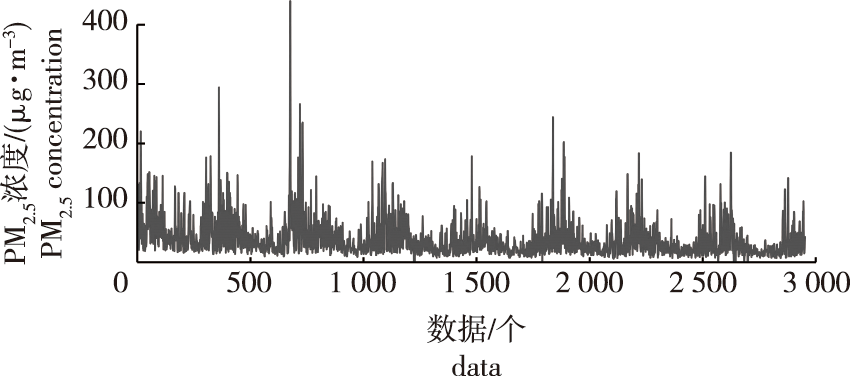 PDF(2848 KB)
PDF(2848 KB)


Improved time series models based on EMD and CatBoost algorithms: taking PM2.5 prediction of Dalian City as an example
ZHAO Lingxiao, LI Zhiyang, QU Leilei
JOURNAL OF NANJING FORESTRY UNIVERSITY ›› 2024, Vol. 48 ›› Issue (3) : 268-274.
 PDF(2848 KB)
PDF(2848 KB)
 PDF(2848 KB)
PDF(2848 KB)
Improved time series models based on EMD and CatBoost algorithms: taking PM2.5 prediction of Dalian City as an example
【Objective】 The study aims to address the problem of low accuracy in traditional PM2.5 concentration time series prediction, and to reduce the impact of nonlinearity, high noise, instability and volatility on the prediction of PM2.5 time series, to predict PM2.5 concentration more accurately. 【Method】 The haze PM2.5 data of Dalian City from January 1, 2014 to January 31, 2022 was used as an example. In this study, a hybrid machine learning time series model with the combination of empirical modal decomposition (EMD), classification boosting (CatBoost) and autoregressive integrated moving average model (ARIMA) was proposed. It was compared with the traditional autoregressive model (AR), ARIMA and the hybrid model with only the EMD method. 【Result】 The hybrid model EMD-CatBoost-ARIMA improved the root mean square error (RMSE) of the original sequence by 20.76%, the mean absolute error (MAE) by 17.40%, and the theil inequality coefficient (TIC) by 29.17%. 【Conclusion】 For reconstructed sequences with high entropy values, the EMD decomposition method and CatBoost algorithm can significantly improve the prediction performance of PM2.5 time series models. Compared with the traditional time series models, the EMD-CatBoost-ARIMA model has higher performance in PM2.5 concentration prediction.

PM2.5 concentration / empirical modal decomposition(EDM) / time series model / hybrid model / CatBoost algorithm / machine learning / Dalian City
| [1] |
World health organization. Ambient air pollution:a global assessment of exposure and burden of disease[M]. Geneva: World Health Organization, 2016.
|
| [2] |
|
| [3] |
|
| [4] |
|
| [5] |
施婷婷, 王帅, 杨立娟, 等. 中国华东地区PM2.5浓度时空变化及与景观格局关联研究[J]. 遥感技术与应用, 2024, 39(2): 435-446.
|
| [6] |
汪伟舵, 吴涛涛, 张子振. 基于ARIMA模型的杭州市PM2.5预测[J]. 哈尔滨师范大学自然科学学报, 2018, 34(3):49-55.
|
| [7] |
|
| [8] |
杨茜雯, 朱萌. 基于ARIMA模型对扬州市PM2.5的分析和预测[J]. 黑龙江环境通报, 2022, 35(1):35-37,40.
|
| [9] |
彭斯俊, 沈加超, 朱雪. 基于ARIMA模型的PM2.5预测[J]. 安全与环境工程, 2014, 21(6): 125-128.
|
| [10] |
严宙宁, 牟敬锋, 赵星, 等. 基于ARIMA模型的深圳市大气PM2.5浓度时间序列预测分析[J]. 现代预防医学, 2018, 45(2):220-223,242.
|
| [11] |
谢心庆, 郑薇, 开璇, 等. 基于时间序列和多元方法的乌鲁木齐PM2.5浓度分析[J]. 云南大学学报(自然科学版), 2016, 38(4):595-601.
|
| [12] |
余辉, 袁晶, 于旭耀, 等. 基于ARMAX的PM2.5小时浓度跟踪预测模型[J]. 天津大学学报(自然科学与工程技术版), 2017, 50(1):105-111.
|
| [13] |
吴明晖, 张广洁, 金苍宏. 基于多模态信息融合的时间序列预测模型[J]. 计算机应用, 2022, 42(8):2326-2332.
|
| [14] |
何泽森. 移动APP日活跃用户量预测研究[D]. 杭州: 浙江工商大学, 2018.
|
| [15] |
|
| [16] |
|
| [17] |
张棋. 基于机器学习的中国气象干旱时空预测研究[D]. 郑州: 华北水利水电大学, 2021.
|
| [18] |
|
| [19] |
|
| [20] |
|
| [21] |
王涯鑫, 李捷辉, 王健. 甲醇-柴油双燃料发动机甲醇泄漏故障预诊断研究[J]. 车用发动机, 2022(1):86-92.
|
| [22] |
|
| [23] |
|
/
| 〈 |
|
〉 |